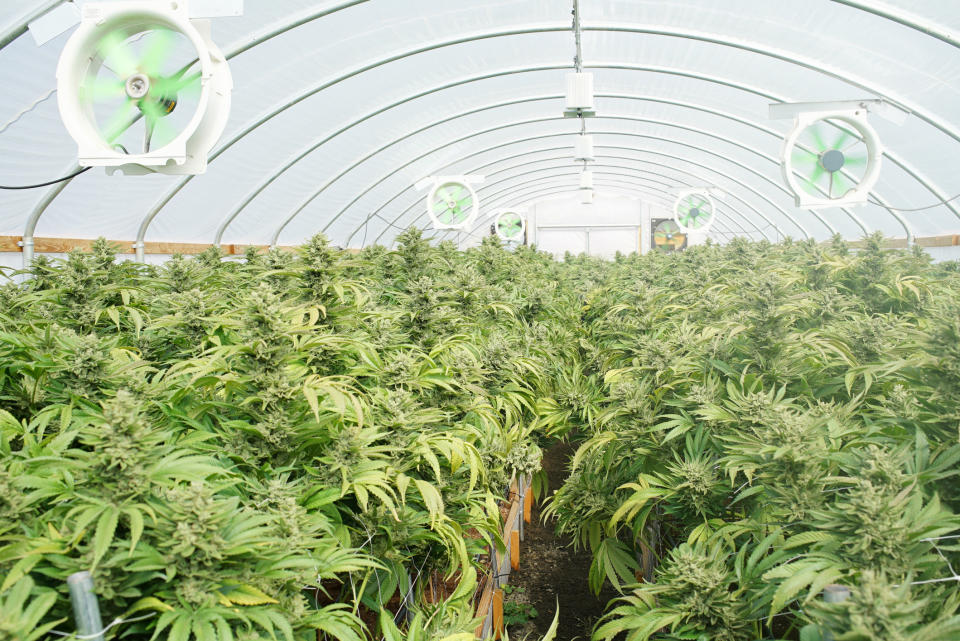1 Figure That Should Have Marijuana Stock Investors Concerned
When it comes to the fastest-growing industries on the planet, it's supposed to be marijuana -- and everything else. The global cannabis industry is expected to see sales expand by 38% in 2019, according to a report released earlier this year by the duo of Arcview Market Research and BDS Analytics, then hit between $50 billion and $75 billion in annual sales by the end of the next decade, up from $12.2 billion in 2018. This type of growth story usually only comes around once or twice per generation.
Note that I said "supposed" to be the fastest-growing industry on the planet. You certainly wouldn't know it right now by looking at the Canadian marijuana market.

Image source: Getty Images.
Canada's cannabis industry falters
Last year, our neighbor to the north made history by becoming the first industrialized country in the world to legalize recreational pot. This paved the way for up to $6 billion in annual sales by 2022, according to aggressive Wall Street estimates. But in the early going, growth has been almost nonexistent. Here's a quick look at cannabis store sales figures (converted from Canadian dollars to U.S. dollars) between the Oct. 17, 2018 launch of adult-use cannabis and January 2019.
October 2018: $32 million
November 2018: $39.6 million
December 2018: $41.6 million
January 2019: $39.7 million
For an industry with as much potential as legal cannabis, a sequential monthly sales decline in January of nearly 5% isn't what the doctor ordered.
What's going on? Part of the problem is tied to regulatory red tape. Health Canada, the agency that oversees licensing and permitting applications, is contending with a backlog of more than 800 applications, which has meant that some of the biggest growers haven't been able to plant or sell product.
Another issue to our north is a shortage of compliant packaging. Health Canada set pretty stringent safety guidelines requiring that packaging be child- and tamper-resistant, and it also laid out regulations on branding, labeling, and package design. There simply haven't been enough compliant packaging solutions available to get more product onto dispensary shelves.

Image source: Getty Images.
Then there's the ongoing ramp-up of capacity at the grow farms themselves. Investing in capacity expansion isn't cheap, and these growers were unwilling to bet big on cannabis until they were certain that the Cannabis Act would become law. This wasn't certain in Canada until very late 2017, or early 2018, meaning growers have been late to the party in terms of ramping up their production.
The good news is that all of these issues are fixable. The bad news is that it's going to take time for these supply-chain kinks to work themselves out, which will negatively affect marijuana stocks with sky-high valuations.
This is the figure that should really have pot stock investors worried
Even though you might think an almost 5% sequential quarterly decline in cannabis store sales is the figure that should have marijuana stock investors worried, it's not. Instead, it's the near-term growth prospects for the face of the marijuana movement, and the largest pot stock of them all, Canopy Growth (NYSE: CGC).
During the fiscal third quarter, reported in mid-February, Canopy Growth wound up generating 97.7 million Canadian dollars in gross revenue, before excise taxes. Why gross revenue? Mainly because that's the figure Wall Street is looking for with its top-line consensus. But in the fiscal fourth quarter, Wall Street is looking for CA$104.6 million.
Put in another context, between the third quarter (October 2018 - December 2018) and fourth quarter (January 2019 - March 2019), Wall Street is only looking for sequential gross sales growth of 7%. In fact, at least one analyst has forecast a sequential sales decline. That's pretty abysmal for a company that's lost more than CA$400 million on an operating basis through the first nine months of fiscal 2019 and is currently valued at a price-to-sales multiple of 125. How Canopy Growth is going to maintain a nearly $15 billion valuation with slowing growth as a result of the Canadian supply chain bottleneck is a question that still needs an answer.

Image source: Getty Images.
The company's legal push into the U.S. hemp market could provide some relief. Canopy Growth was awarded a hemp-production and processing license in New York State three months ago, and it plans to spend between $100 million and $150 million constructing a processing facility in the southern portion of the state. But even with this product diversification, it's not going to be an immediate revenue producer.
Acquisitions may also provide a boost. Canopy was flush with $3.7 billion in cash and cash equivalents as of the end of December, and purchasing complementary companies is part of its long-term strategy.
But even here, there's concern. The company has arguably been overpaying for the businesses it's acquired, as evidenced by the CA$1.82 billion in goodwill it's now lugging around on its balance sheet. This is up almost fivefold from the end of 2017. It's no guarantee that this premium Canopy has paid for other companies will be recouped, leaving open the very real possibility of future writedowns.
Can marijuana stocks push forward if the face of the industry is struggling? I guess we'll soon find out!
More From The Motley Fool
Sean Williams has no position in any of the stocks mentioned. The Motley Fool has no position in any of the stocks mentioned. The Motley Fool has a disclosure policy.

 Yahoo Finance
Yahoo Finance 